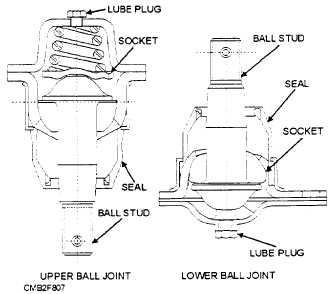vehicle. With the independent front suspension the use of ball joints provides pivot points for each wheel. In operation, the swiveling action of the ball joints allows the wheel and spindle assemblies to be turned left and right and to move up and down with changes in road surfaces. This type of suspension is most widely used on modern vehicles.
SUSPENSION SYSTEM COMPONENTS
The basic components of a suspension system are as follows:
CONTROL ARM (a movable lever that fastens the steering knuckle to the vehicle frame or body)
CONTROL ARM BUSHING (a sleeve, which allows the control arm to move up and down on the frame)
STRUT ROD (prevents the control arm from swinging to the front or rear of the vehicle)
BALL JOINTS (a swivel joint that allows the control arm and steering knuckle to move up and down, as well as side to side)
SHOCK ABSORBER or STRUT (keeps the suspension from continuing to bounce after spring compression and extension)
STABILIZER BAR (limits body roll of the vehicle during cornering)
SPRING (supports the weight of the vehicle; permits the control arm and wheel to move up and down)
Control Arms and Bushings
The control arm, as shown in figure 8-6, holds the steering knuckle, bearing support, or axle housing in position, as the wheel moves up and down. The outer end of the control arm has a ball joint and the inner end has bushings. Vehicles, having control arms on the rear suspension, may have bushings on both ends.
The control arm bushings act as bearings, which allows the control arm to move up and down on a shaft bolted to the frame or suspension unit. These bushings may be either pressed or screwed into the openings of the control arm.
Strut Rods
The strut rod. as shown in figure 8-6, fastens to the outer end of the lower control arm and to the frame. This prevents the control arm from swinging toward the rear or front of the vehicle. The front of the strut rod has rubber bushings that soften the action of the strut rod. These bushings allow a controlled amount of lower control arm movement while allowing full suspension travel.
Ball Joints
The ball joints (fig. 8-7) are connections that allow limited rotation in every direction and support the weight of the vehicle. They are used at the outer ends of the control arms where the arms attach to the steering knuckle. In operation, the swiveling action of the ball joints allows the wheel and steering knuckle to be turned left or right and to move up and down with changes in road surface.
Since the ball joint must be filled with grease, a grease fitting and grease seal are normally placed on the joint. The end of the stud on the ball joint is threaded for a large nut. When the nut is tightened, it force fits the tapered stud in the steering knuckle or bearing support.
Shock Absorbers and Struts
Shock absorbers are necessary because springs do not "settle down" fast enough. After a spring has been compressed and released, it continues to shorten and lengthen for a time. Such spring action on a vehicle would produce a very bumpy and uncomfortable ride. It would also be dangerous because a bouncing wheel makes the vehicle difficult to control; therefore, a dampening device is needed to control the spring

Figure 8-7. - Upper and lower ball joint.
Continue Reading